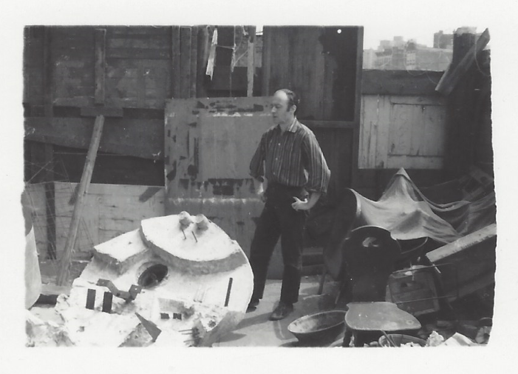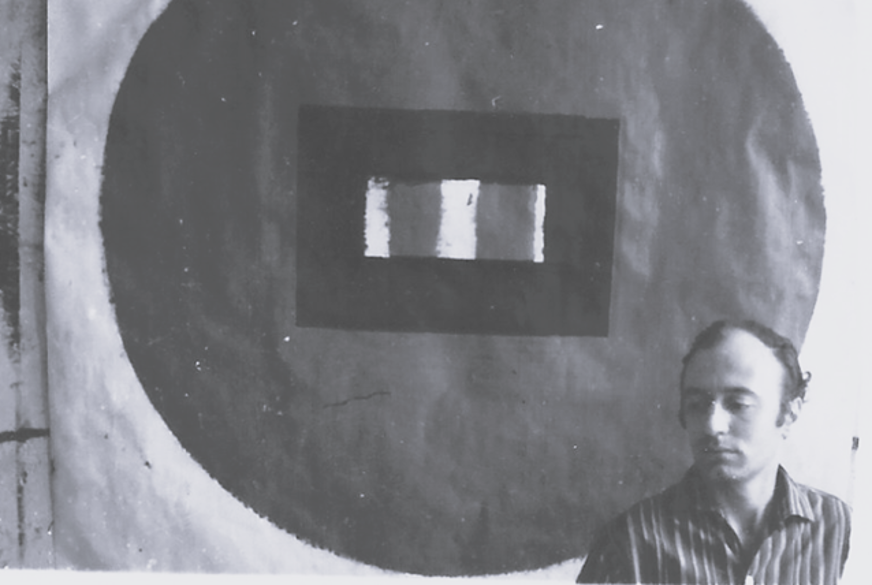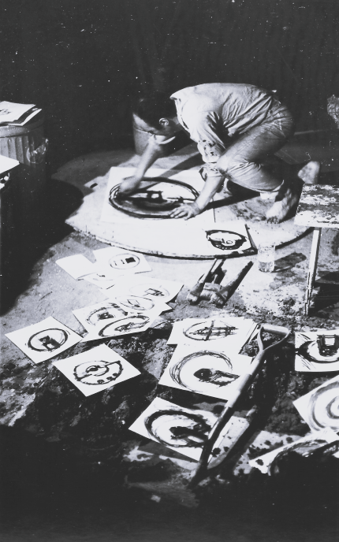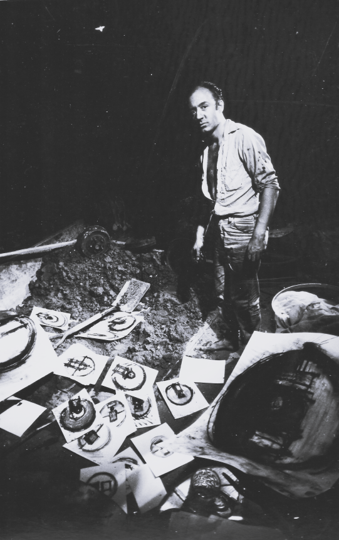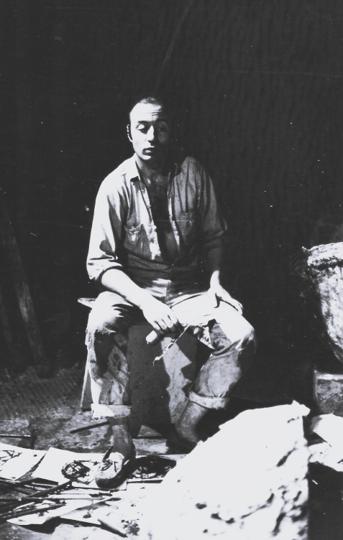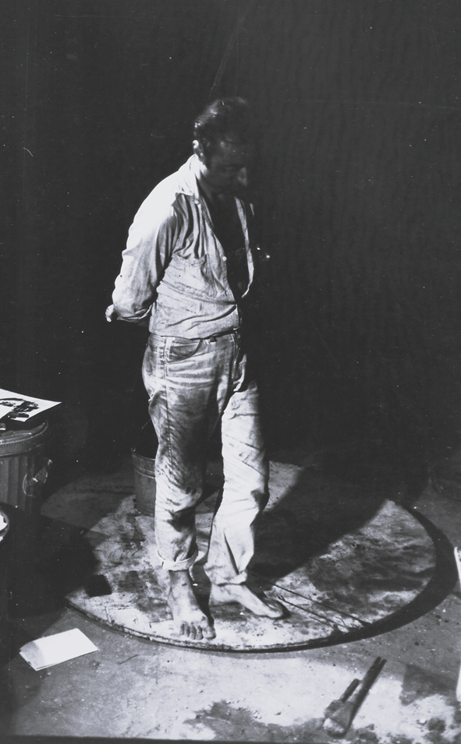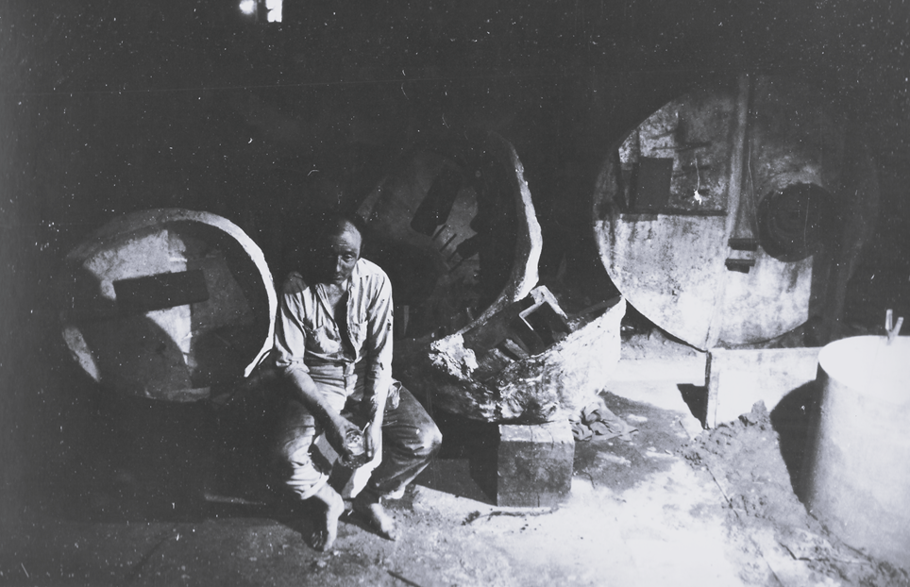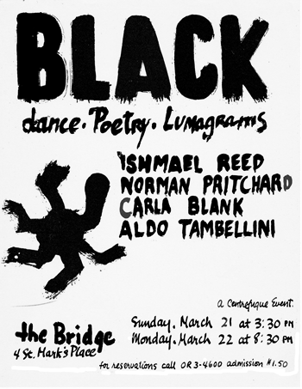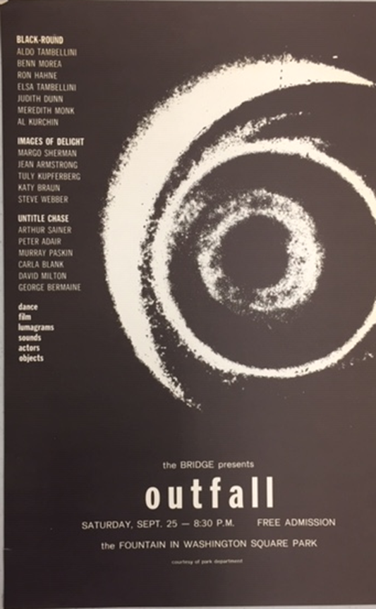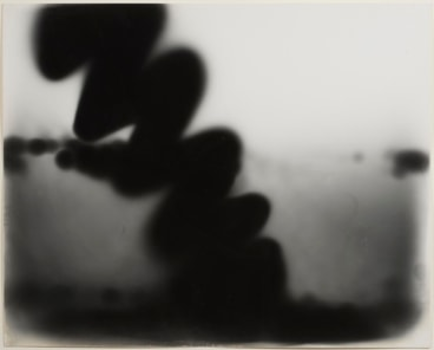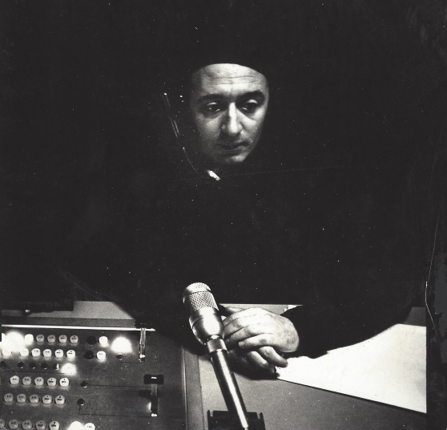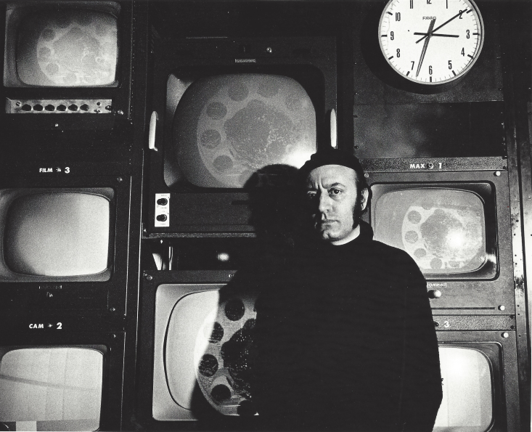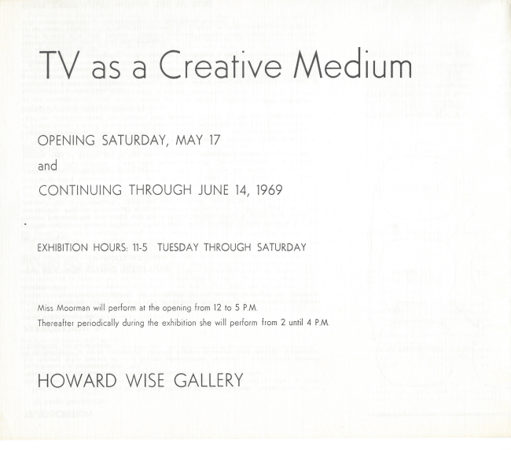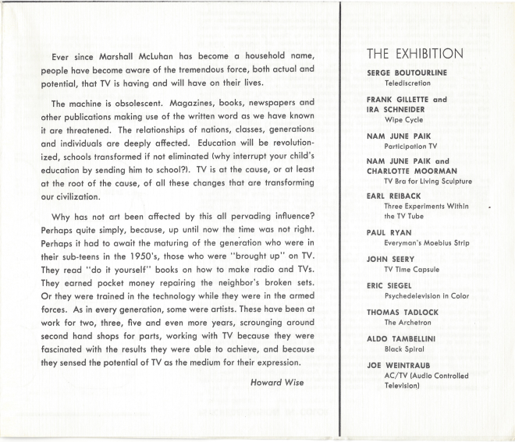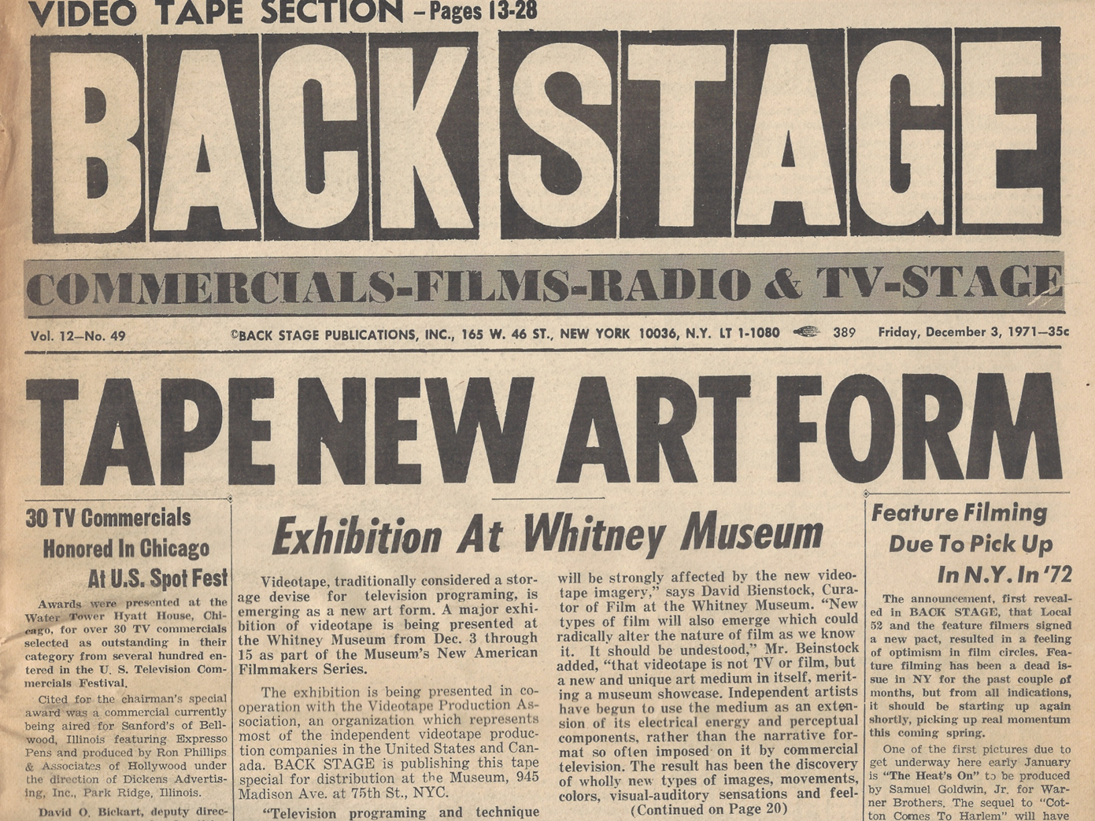1959-1976
New York Years
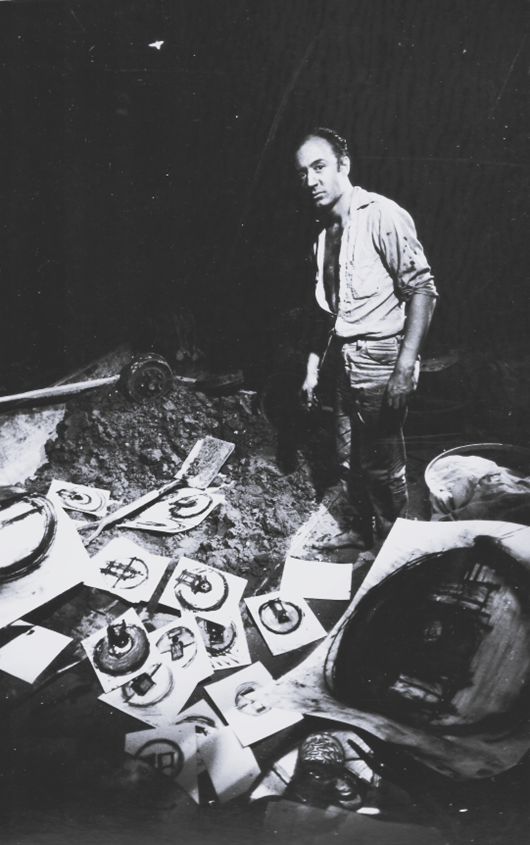
1959
Tambellini moved to New York’s Lower East Side in the summer of 1959 and began to advance a new phase of his work, dominated by black and the circular form. It was also at this time that Tambellini began to only wear black; using Black in the titles of his works and focusing on building Avant-Garde artist communities and street politics.
“It was an intense black which came out spontaneously as a primordial focus and I fully embraced it when I first moved to New York.”
-Aldo Tambellini
“The color BLACK both color and a negation of color, for me holds in its depth and vastness the seed of all creation, of all that is in the cosmos. In the larger metaphor, black represents all that is in the universe, the black of deep space; while on Earth, it represents the racial struggle and the inequality facing segments of the population in the United States.”
-Aldo Tambellini, 1959
Working with Boris Lurie, Sam Goodman and Stanley Fisher, Tambellini became involved with NO!art, a radical avant-garde anti-art-establishment movement.
1960
Tambellini met Elsa Morse, an artisan weaver, who became his companion, work partner and supporter for the next decade.
During this time, Tambellini was exposed to what is perhaps his greatest literary influence, the hard, surrealistic writing of Federico García Lorca, whose portrayal of the difficult and cruel life in New York City paralleled Tambellini's own experience.
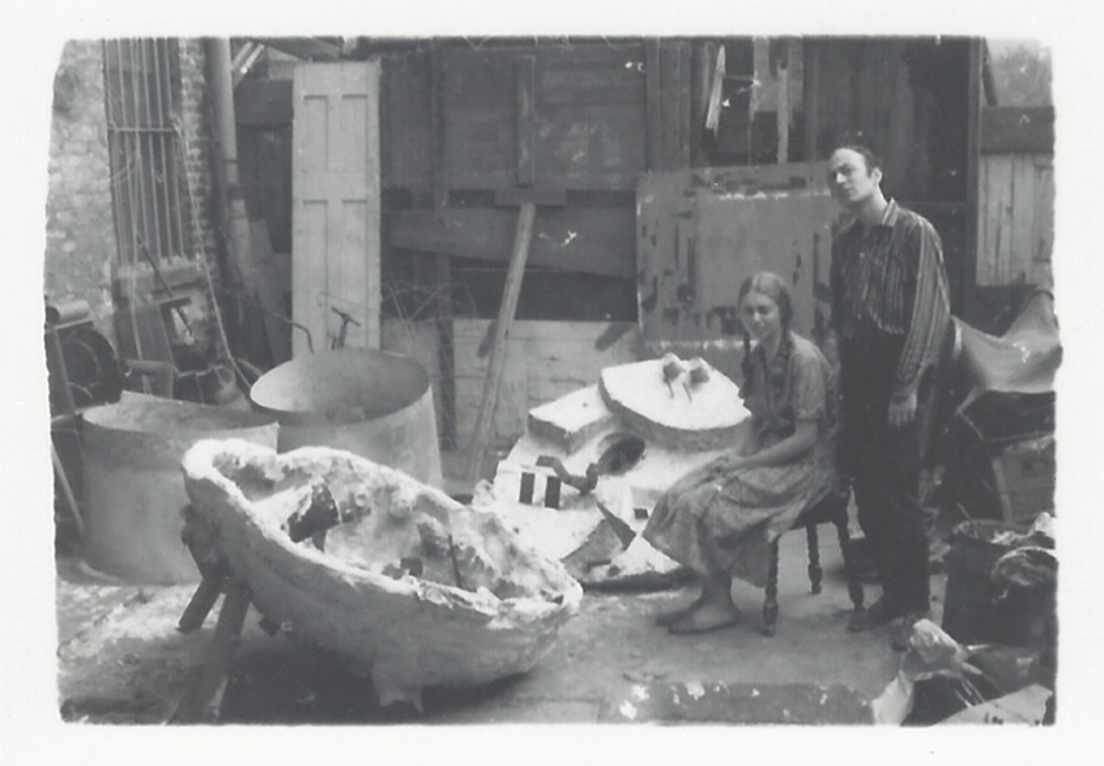
Tambellini and Elsa Morse, Semptember, 1961
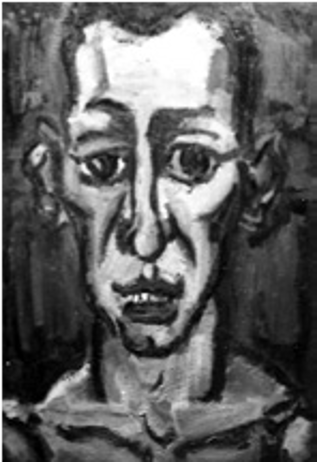
Self-portrait
oil on canvas, 39 x 30 in.
1961
“I was influenced early in my development by the… Expressionism represented by Georges Rouault.”
-Aldo Tambellini, 1961
Tambellini develops his Cryptic Symbols and Signs Series, edging towards the completion of the circle and eradicating the signs and symbols, thus paving the way for his forthcoming stage of paintings.
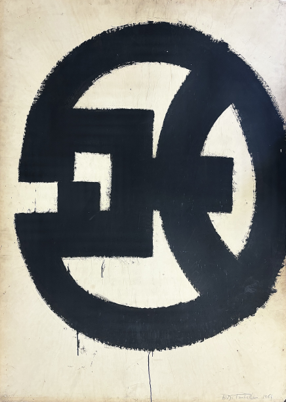
Untitled
Cryptic Symbols and Signs Series, ca. 1961
acryclic on paper, mounted on board
60.5 x 42.5 in.
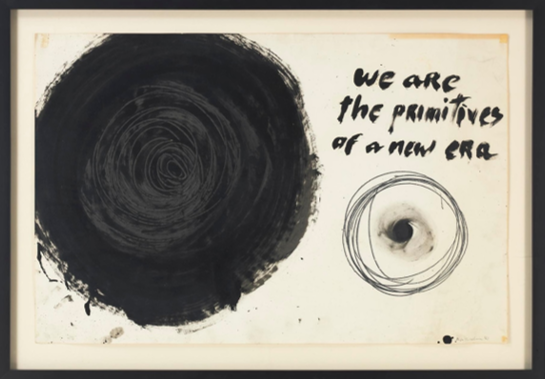
We Are The Primitives Of A New Era
Manifesto Series, 1961
duco and writing on paper
25 x 30 in.
Tambellini created his Manifesto Series, a group of seven paintings, which includes his signature piece,
We Are The Primitives Of A New Era.
Tambellini created his Destruction I Series. Using cardboard, he burned and made incisions on the surface.
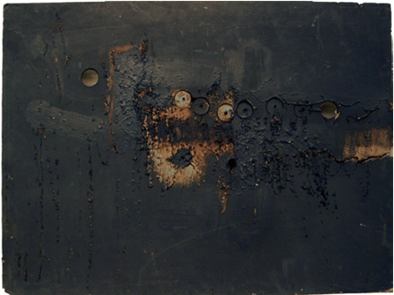
Destruction 21
The Destruction 1 Series, 1961
graphite with incisions and burns on cardboard
28 x 36 in.
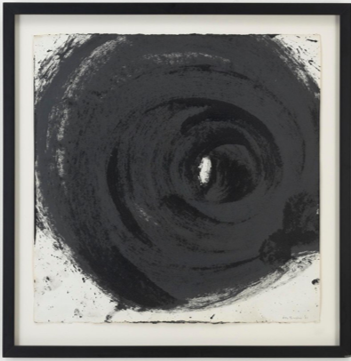
Untitled
To Be Enveloped by Black Series, 1961
duco and sand on paper
26 x 26 in.
Tambellini develops his series To Be Enveloped By Black by purposefully leaving certain areas of the paper unpainted, revealing the paper beneath and emphasizing the black envelopment of the work.
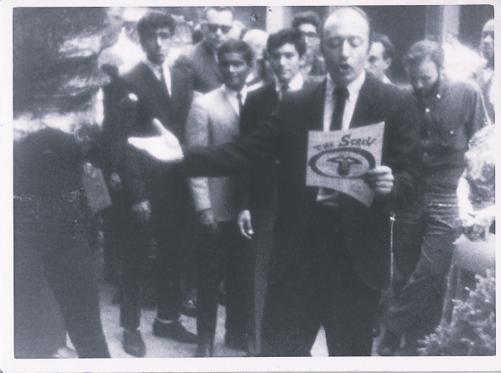
As a counter-culture activist, Tambellini wrote, edited and published a newsletter called The Screw, with its slogan “Artists in an Anonymous Generation Arise.” Written mostly in poetry form, it was first published in 1962. The newsletter was created to raise the social consciousness of the artists.
1962
“The attitude of what was called underground in New York in the early 1960's was to break the rules and definitions of what the arts were about and create new artistic forms. What we were doing was not what the ‘establishment’ was doing, in the art context.”
-Aldo Tambellini
Tambellini voiced his objection to the manipulation he saw in the art establishment, which used the artists as a commodity and financial investments rather than cultural entities. The Event of the Screw, a protest in the form of a performance, took place on July 12, 1962, in front of the Museum of Modern Art, the Guggenheim Museum and Whitney Museum in New York.
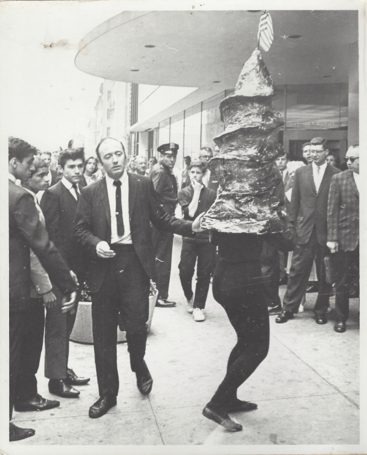
Tambellini presents his agitprop performance, The Event of the Screw, in front of Museum of Modern Art, NYC, NY
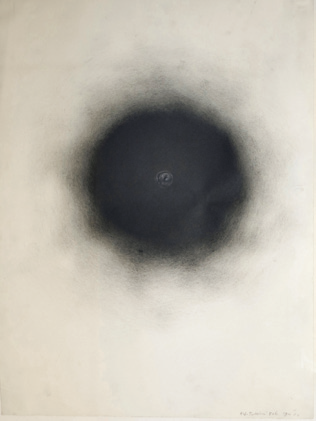
The Seed 11
Black Seed of Cosmic Creation Series, 1962
duco and graphite on paper
26 x 26 in.
Tambellini's departure from the Cryptic Symbols and Signs Series led to the creation of the Black Seed of Cosmic Creation Series. In this progression, Tambellini embarked on a journey to fill in his circles and embellish them by marking their boundaries with faded charcoal and sporadically applying splattered paint, thus imitating the essence of a cosmic phenomenon.
Tambellini explores the use of color in his work, creating the Black Energy Burns With Fire Series.
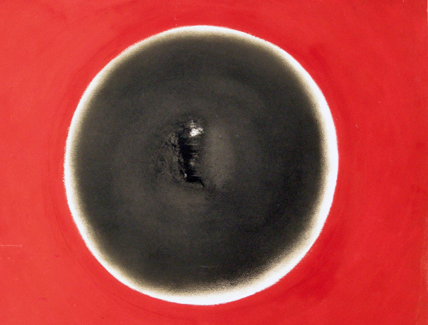
Black Energy 1
Black Energy Burns With Fire Series,1962
duco and acrylic on cardboard
30 x 39 in.

On Becoming 3
On Becoming Series, 1962
acrylic, printers’ ink with cuts on paper
30 x 42 in.
Tambellini introduces distressed paper in his work by cutting and manipulating it to form unique layers, which, when assembled, result in a three-dimensional art piece he refers to as sculptural painting.
With Ron Hahne, Elsa Tambellini, Don Snyder, Ben Morea, Jackie Cassen and Peter Martinez, in 1962, Tambellini founded the counter-cultural alliance, Group Center, an artists’ collective focused on activism and intent on challenging the art establishment and creating new ways to present art to the public, outside of the institution. An excerpt from their credo reads, “ We feel the hunger of a society lost in its own vacuum and rise with an open active commitment to forward a new spirit for mankind.”

Tambellini (second from the left) at The Center Show, St. Mark’s Church in-the-Bowery, 1963
Photo by Don Snyder
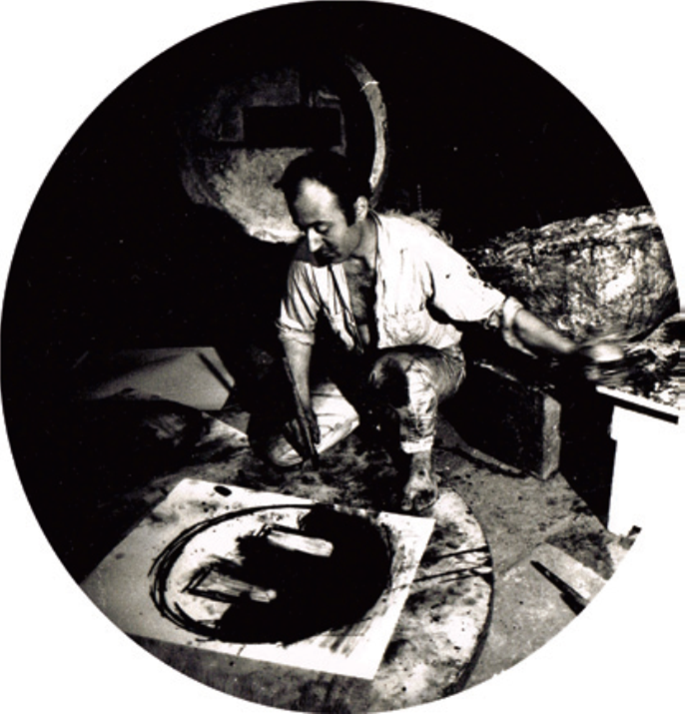
Tambellini in his studio, ca. 1962. Photo by Don Snyder
“I was also aware and an admirer of the Futurists, I was familiar with the arial painting by Azari and of Fontana's and their Manifestos, I embraced Spazialismo the concept of an art that had to deal with outside of the Earth. My works, later in my development, were executed as if I were flying above the canvas and having an arial view.”
-Aldo Tambellini
1963
Tambellini begins to develop his own method to sculpture by employing sand casting with hydrocal. His initial semi-spherical sculptures were cast without any knowledge of their eventual internal composition, a technique he referred to as "Sculpting in the Blind." In order to accommodate his sculptures, Tambellini and his partner Elsa relocated to a ground floor storefront in the Lower East Side. With the assistance of local children, Tambellini transformed an abandoned lot adjacent to his apartment into an open-air sculpture studio and exhibition area accessible to the community.
“Two weeks ago we went into the tough Lower East Side of New York City to visit a sculptor…32 years old Aldo Tambellini, native of Syracuse, is a rebel with a following. He and his pleasant wife, Elsa, live in a drab, cramped little storefront studio at 217 East 2nd Street. In the back yard of this environment Tambellini uses concrete and jagged pieces of metal from junk yards to create dramatic often brutal sculptures. He creates raw, primitive, forms from industrially created shapes… iron, steel nails, pieces of pipe.”
Walter Carroll, The Syracuse Post–Standard Sunday Pictorial Magazine
“A SYRACUSE REBEL IN NEW YORK”, January 27, 1963
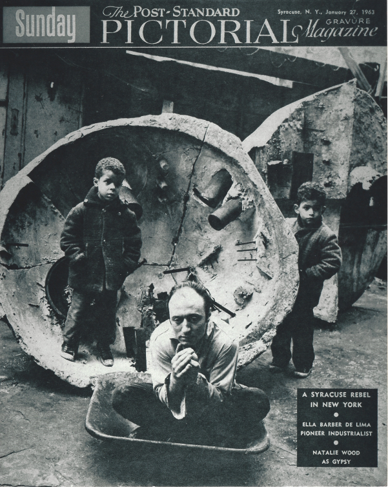
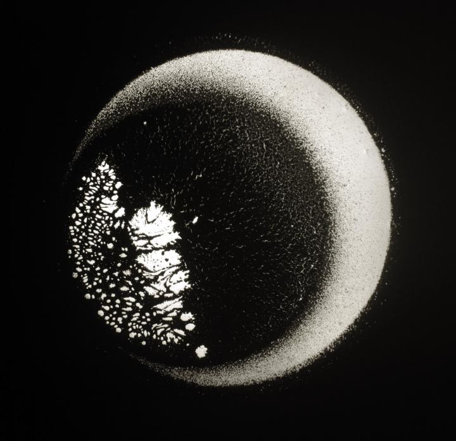
“Lumagram,” a hand painted glass slide, 3 x 3 in., ca. 1963
Tambellini took discarded 35 MM slides and intuitively used needles and other tools to scratch the emulsion, creating spirals and other round forms, sometimes piercing holes through the slides. Seeking, as always, to incorporate his environment in his iconography, he projected these manipulated slides onto the facade of the building across the street from a tenement rooftop on 6th Street and Avenue D using a Kodak Carousel Projector. He then began to paint on glass mounts for slides and called them “Lumagrams.” This was the beginning of his multimedia development, which he termed “Electromedia.”
“Group Center” organized a Festival-of-the-Art in collaboration with Lower East Side Neighborhood Association (LENA). Tambellini curated the event to highlight the young artists that were beginning to live on the Lower East Side. A two week marathon of art shows, poetry readings, underground films and jazz concerts was organized and held at and around the Church of St. Mark’s-in-the-Bowery
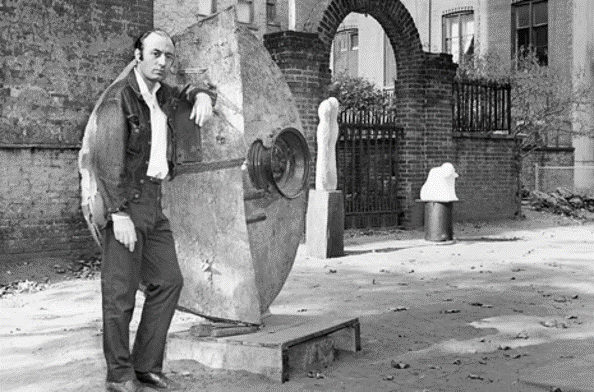
Tambellini leans against one of his sculptures in the Churchyard of St Mark’s Church, New York, 1963
1964
Tambellini continued to cultivate his internal motivation to express a profound interpretation of the circle as a symbol representing the fusion of the past, present, and future. Immersing himself in his artistic pursuits, he dedicated his efforts to producing paintings using acrylic and black duco on paper, with certain pieces intricately shaped into circles. Moreover, he utilized a blowtorch to burn sizable cardboard pieces, at times incorporating paint into the technique. Additionally, he experimented with fire on a series of plexi-glass discs.
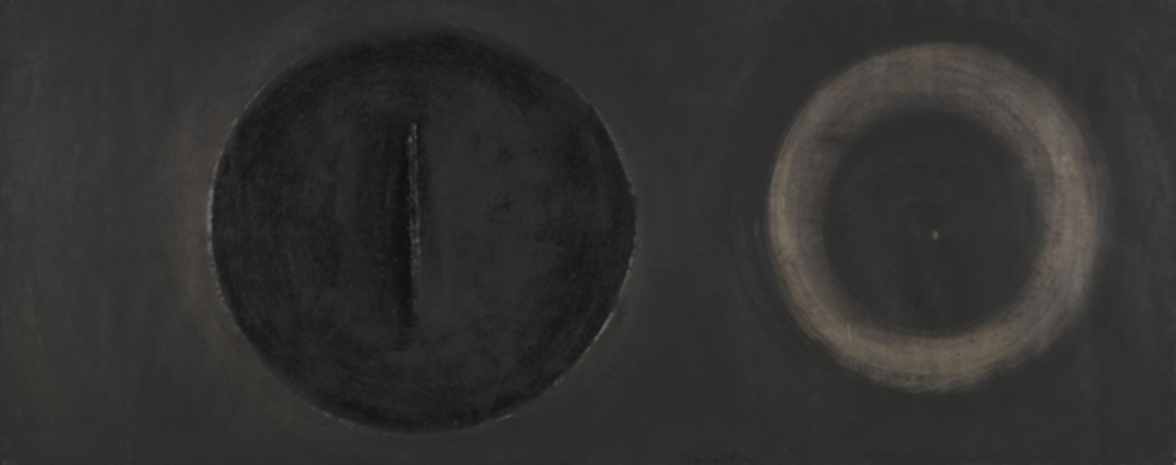
Silent Echo of Solitude Series, 1964, duco, acrylic, and graphite on paper, Tate Collection
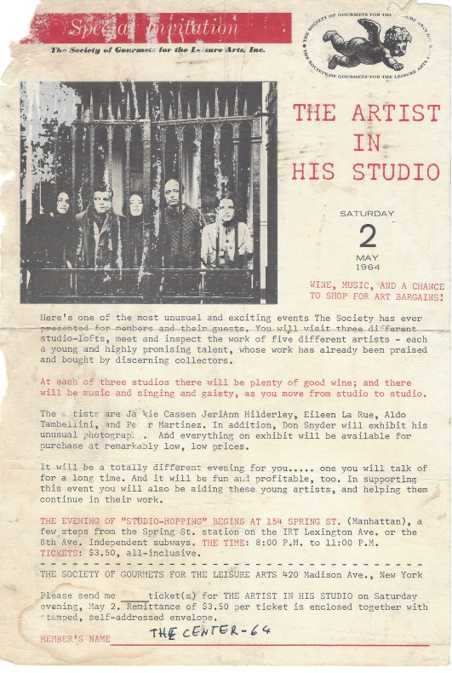
“We organized what could now be considered the First Independent Loft Show bringing the artist’s work and his living working space directly to the public bypassing the establishment art system. The loft show of painting and sculpture was taking place in four different lofts. The area had been made up of large manufacturing buildings which some artists were using as living and working spaces. This very area later became known as SOHO where ironically the most powerful commercial galleries relocated form up-town Manhattan. My loft was located on the 4th floor of 414 West Broadway near Spring Street.”
-Aldo Tambellini
1965
Tambellini began to burn, scratch, and paint directly on found film stock, beginning his Black Film Series (1965–69). These experimental films, characterized by their politically charged abstract nature, were shot at high speed and accompanied by Tambellini’s distinct soundtrack, ultimately establishing themselves as his signature creations.
He then began to explore combining projected paintings, film, video, poetry, light, dance and sound with live music, creating what he called, “Electromedia Performances.” Participating in the performances were UMBRA Poets, Ishmael Reed, H.N. Pritchard, Calvin Hernton, and Roland Snelling subsequently known as Askia Toure, reading their own poetry. His first Electromedia Performance, “Black,” debuted at the International House of Columbia University in 1965.
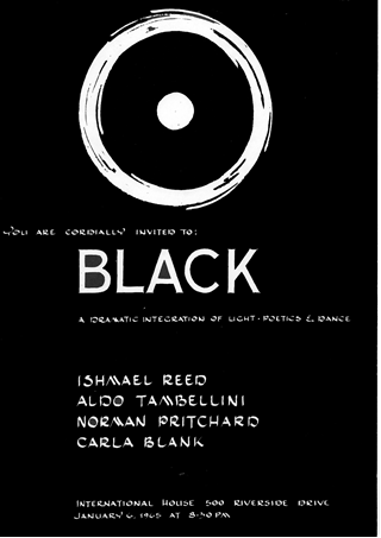
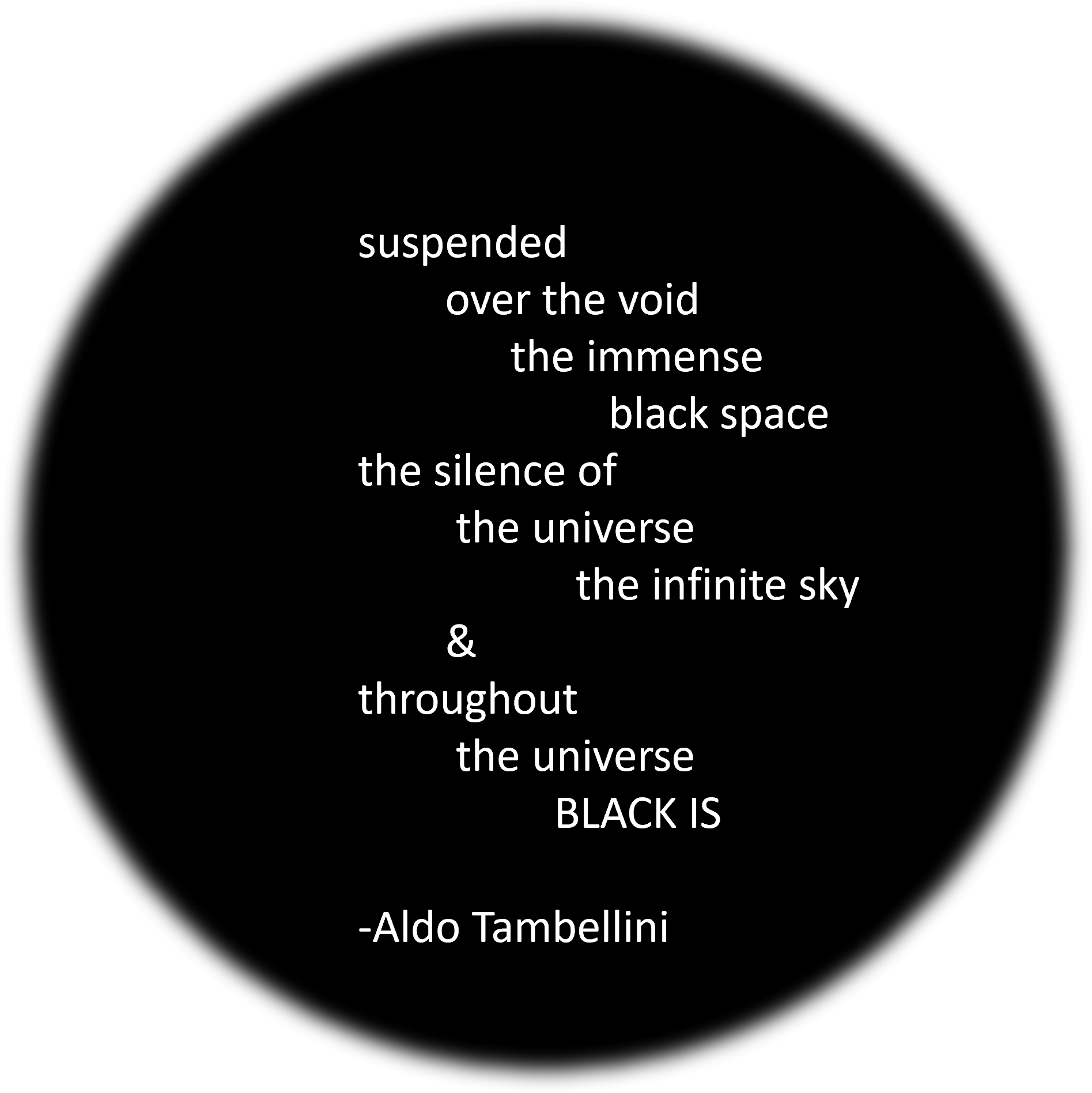
On March 18, 1965, Alexei Arkhipovich Leonov, a Soviet and Russian cosmonaut, Air Force major general, writer, and artist, becomes the first person to conduct a spacewalk, exiting the capsule during the Voskhod 2 mission for 12 minutes and 9 seconds. Already immersed in black, for Tambellini, Leonov’s description of this experience, referencing the depth of space and the blackness of the void, only confirmed what Tambellini already believed and was attempting to capture in his work.
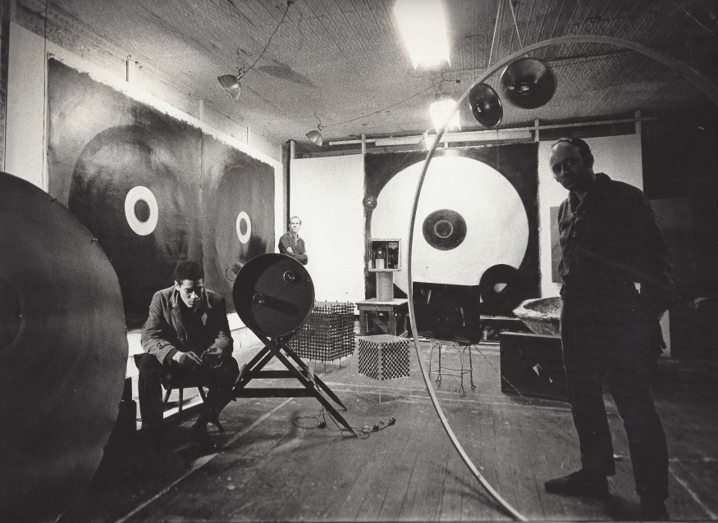
Aldo Tambellini, with Eric Mingus, son of Charles Mingus, at Tambellini’s studio, 414 West Broadway, New York, NY. Photo by Don Snyder, 1965
“He is an easy mark for ridicule for those who don’t know him. Those who do respect him. They may not know what he is doing and they might even doubt that he does, but they will know that he will not swerve from his path. In a time of opportunism, they find something splendid in this principled obstinancy.”
“New York Herald Tribune”, June 13, 1965, “Rebellion in Art Form: Tambellini’s Black 2” feature article by Don Ross
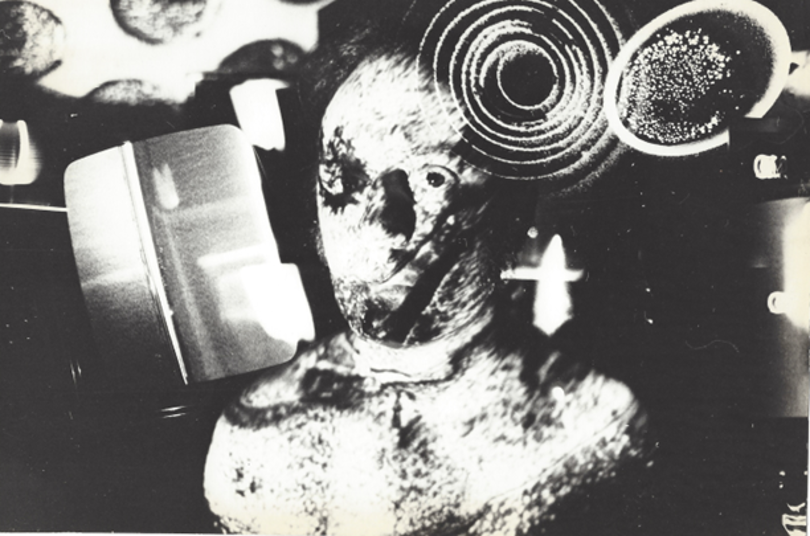
Tambellini immersed in an Electromedia environment
Tambellini became aware of Otto Piene’s work, when he attended the Howard Wise Festival of Lights exhibition, where Group Zero was exhibiting. Tambellini invited Piene and Group Zero to exhibit at Quantum 1 and 2, exhibitions Tambellini was curating at the Noah Goldowsky & A.M. Sachs Galleries in New York. This marked the beginning of Tambellini and Piene’s collaboration.
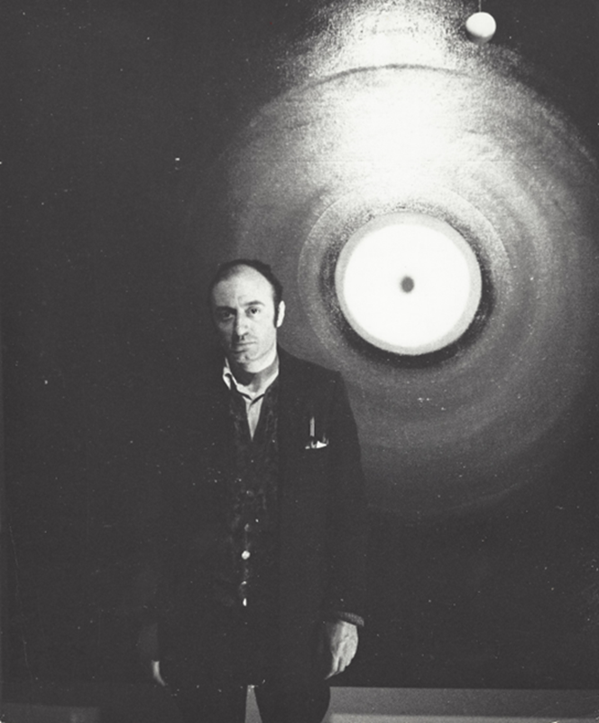
Tambellini in front of his painting, The Strobe, Quantum 1 Exhibition, A.M. Sachs Gallery, NYC, NY, Photo by Aaron Rose
Tate Collection
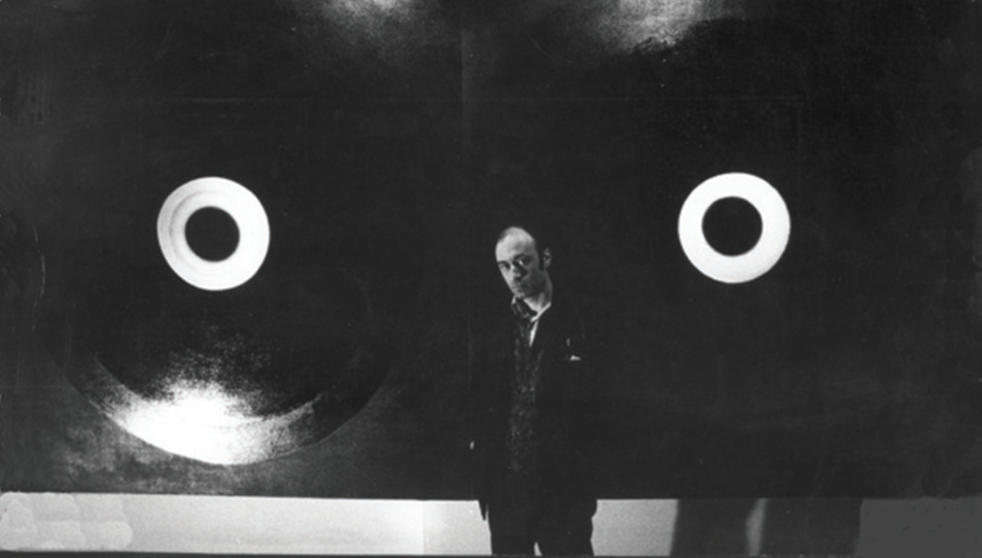
Tambellini, The Echo: A Spatial Painting, duco enamel on canvas, 8 x 16’
Quantum 2 Exhibition. A.M. Sachs Gallery, NYC, NY, 1965.
Photo by Aaron Rose
1966
Elaine Summer, who was in the audience of BLACK in 1965, invited Tambellini to repeat the performance at the Bridge Theatre at St. Mark’s Place where she was special program director. This was the beginning of Tambellini’s collaboration with the Bridge Theater, leading to a three part program called OUTFALL which was presented by the Bridge Theatre in conjunction with ”Group Center” under the auspices of the New York City Department of Parks at the Fountain in Washington Square.
The Gate Theatre, Elsa and Aldo Tambellini’s venue for underground film, was opened in protest to the Fourth American Film Festival held at Lincoln Center.
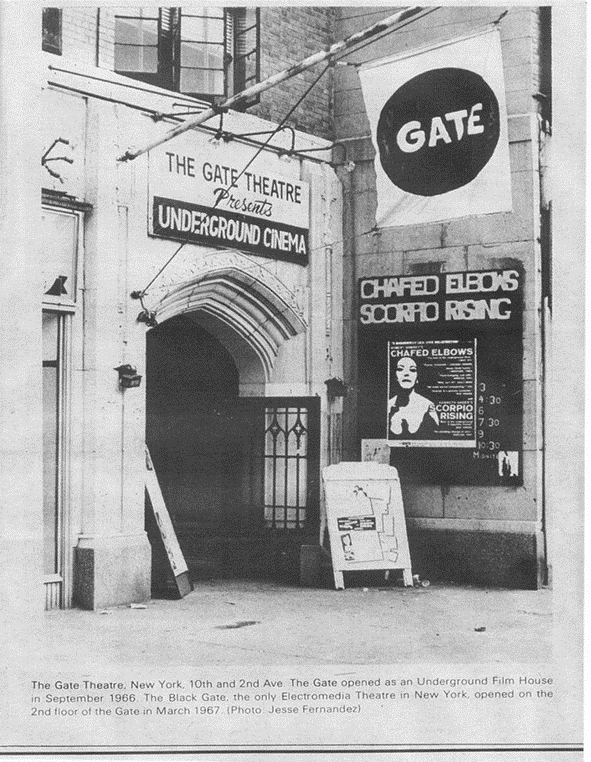

Aldo and Elsa Tambellini, ca. 1966
The Gate Theater showed experimental films seven days a week, the only avant-garde experimental theater that showcased independent films at the time. Prominent avant-garde filmmakers such as Kenneth Anger, Stan Brakhage, Jack Smith, Robert Downey, and Brian de Palma introduced their work at the Gate. One notable program at the Gate was called Psychedelia Tune In, where Dr. Ralph Metzner, an associate of Dr. Timothy Leary, held a discussion titled Psychedelic No-Art. Richard Aldcroft also presented his Infinity Machine, which had previously been featured on the cover of Life Magazine in 1966. Additionally, the program included screenings of experimental films by Jud Yalkut and Bruce Conner, as well as Tambellini’s Black films. The Gate also became the home of the Theatre of the Ridiculous, directed by Charles Ludlam, which performed there every weekend from 1:00 a.m. to 3:30 a.m. The cast included notable members such as Mario Montez, Black-Eye Susan, and Jack Smith. Their plays, including When Queens Collide, Dracula, and Grant Hotel, were parodies that garnered attention.
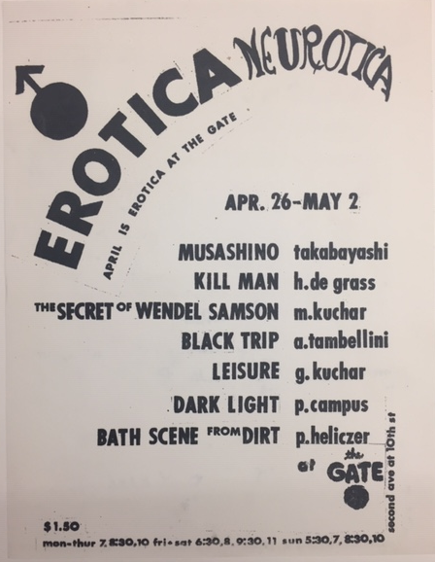
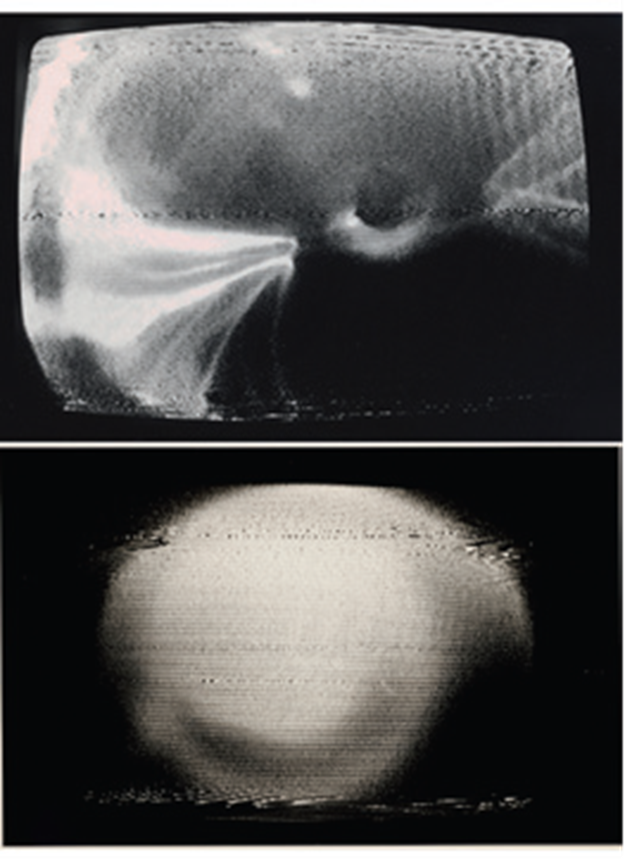
Black Video 1, 1966, First video tape: an experiment with light, audio feedback & voice improvisation.
Photo by Peter Moore
During this time, Tambellini also focused on exploring different methods of creating visual effects through video and television. He set a video camera and experimented with audio feedback, voice improvisation and light. Shining intense light into the lense of the camera, burned the vidicon, leaving marks which were visible in future tapes. These effects were then edited into a video called Black Video 1, becoming an additional instrument in his Electromedia orchestra. Tambellini's striking video imagery caught the attention of the local ABC news affiliate, leading to a clip being aired on the evening news in 1967. This event made Tambellini realize the potential of television as a medium for artistic communication on a mass scale.
Jonas Mekas reviewed Tambellini’s performance MOONDIAL in his Movie Journal Column on June 23, 1966 which appeared in The Village Voice: “It (MOONDIAL) is one of those few cases where everything seemed to work perfectly… .The flashes and glimpses of light and slides, and the dancer, all together, produced an aesthetically unified performance.”
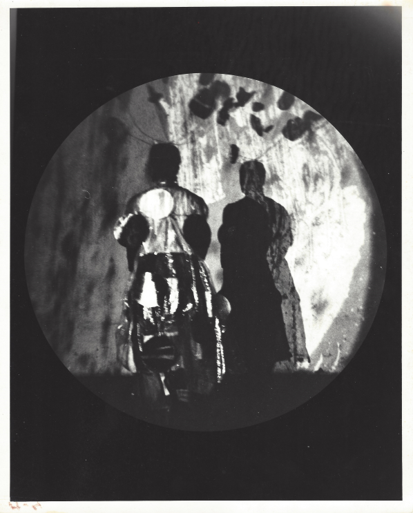
Moondial Performance, Beverly Schmidt dancer, The DOM, New York, NY 1966
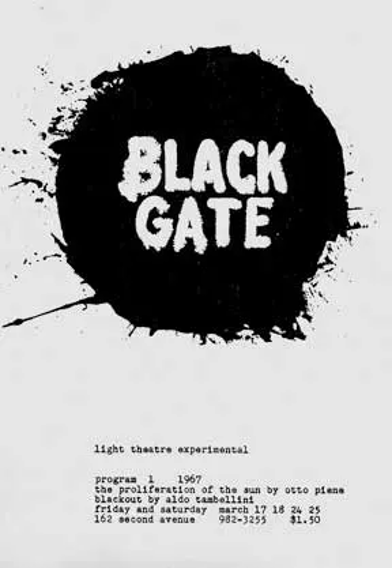
1967
Together with Otto Piene, Tambellini founded a second theater, above the Gate Theater, called the Black Gate, the first theater in New York devoted to Electromedia, performances and installations. They inaugurated the space with the double performances of Tambellini’s Black Out and Piene’s The Proliferation of the Sun (1964-67).
Many artists performed at the Black Gate, including Jack Smith, Jud Yalkut, Nam June Paik and his partner Charlotte Morman, and Yayoi Kusama with her debut of Obliteration.

Kusama’s Self-Obliteration, 1967 at the Black Gate Theater
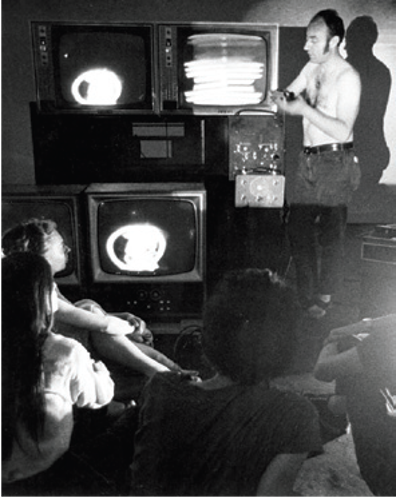
Black Video 2, 1967, Tambellini manipulating images at Black Gate Theater, 1968
Tambellini visited Video Flight near LaGuardia airport in New York to make a copy of his initial tape, Black Video 1. While the duplication was taking place, Tambellini observed test patterns and electronic images on the monitors that intrigued him. With the assistance of Video Flight's engineers, Tambellini developed Black Video 2, which was showcased at the Festival of Lights Show held at the Howard Wise Gallery in New York, NY, in 1967. This technique of electronically manipulating video images became the inspiration for Tambellini`s future artistic endeavors, which concerned integrating the artist into collaborative and participatory moves that break down the conventional artwork into otherworldly perceptual experiences.
Anne Brodzky, the new editor of artscanada, asked Tambellini “Why Black,” in a October 1967 special issue on the subject of “Black,” to which he answered: “Black to me is like a beginning. A beginning of what it wants to be rather than what it does not want to be. I am not discussing black as a tradition or non-tradition in painting or as having anything to do with pigment or as an opposition to color. As I am working and exploring black in different kinds of dimensions, I’m definitely more and more convinced that black is actually the beginning of everything, which the art concept is not. Black gets rid of the historical definition. Black is a state of being blind and more aware. Black is a oneness with birth. Black is within totality, the oneness of all. Black is the expansion of consciousness in all directions.” He continued, “Black is one of the important reasons why the racial conflicts are happening today, because it is part of an old way to look at a human being or race in terms of color. Black will get rid of the separation of color at the end. Blackness is the beginning of the re-sensitizing of human beings. I strongly believe in the word ‘black power’ as a powerful message, for it destroys the old notion of Western man, and by destroying that notion it also destroys the tradition of the art concept.”
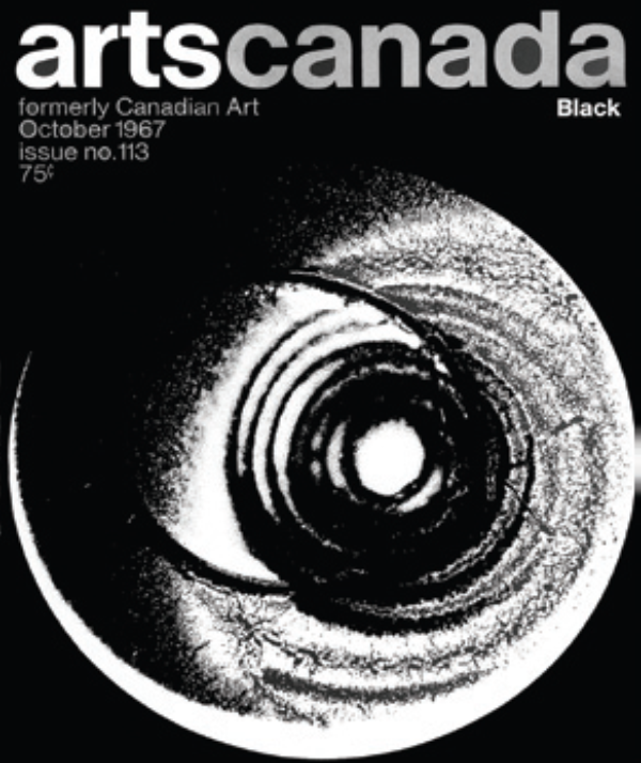
Tambellini’s Lumagram on the cover of the artscanada Black Issue, artscanada, 24, no. 113, October 1967
1968
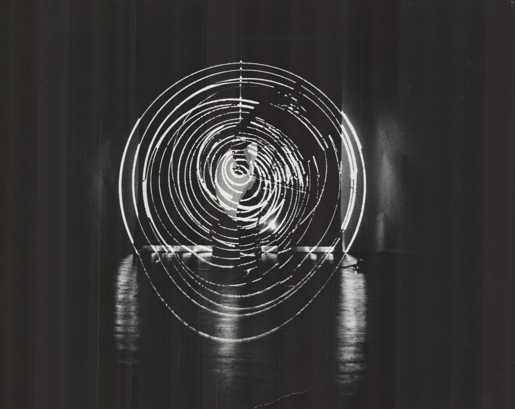
Black Zero Performance, Brooklyn Academy of Music, 1968, Callo Scott on amplified cello
The final iteration of Black Zero, which included, for the first time, television, is widely recognized as Tambellini’s most important and politically charged piece, and was performed as part of the Some More Beginnings show, organized by Experiments in Art and Technology (E.A.T.), Intermediate 68. Black Zero is performed at the Brooklyn Academy of Music, Brooklyn, NY.
1968 was also the culmination of Tambellini and Peine’s collaboration, an Electromedia performance, Black Gate Cologne, produced for broadcast by (WDR), Cologne. This tape is now widely acknowledged as the first broadcast television program to involve artists in collaboration with television producers to create a non-commercial, visual experience.
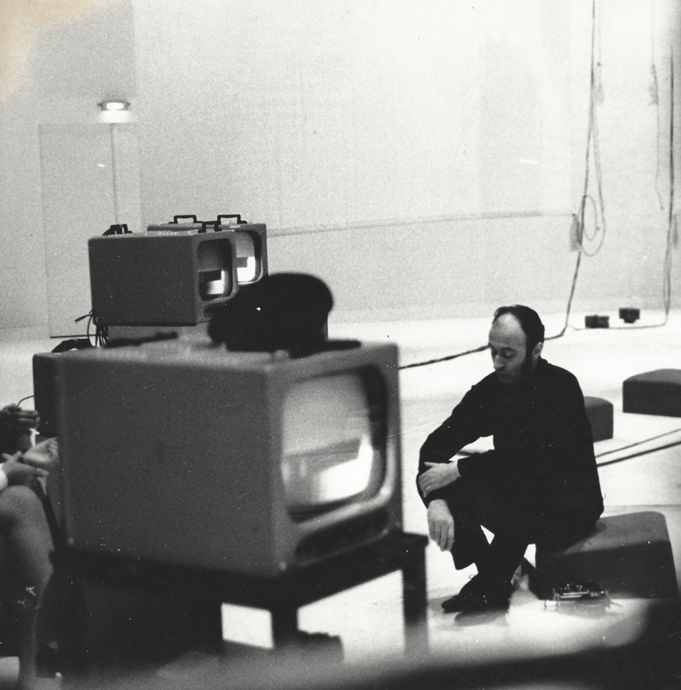
Tambellini at Black Gate Cologne, Aug 30, 1968
Photo by Peter Kliem
1969
Tambellini begins his television artist in residence, creative video, tape recording project, New York State Department of Education.
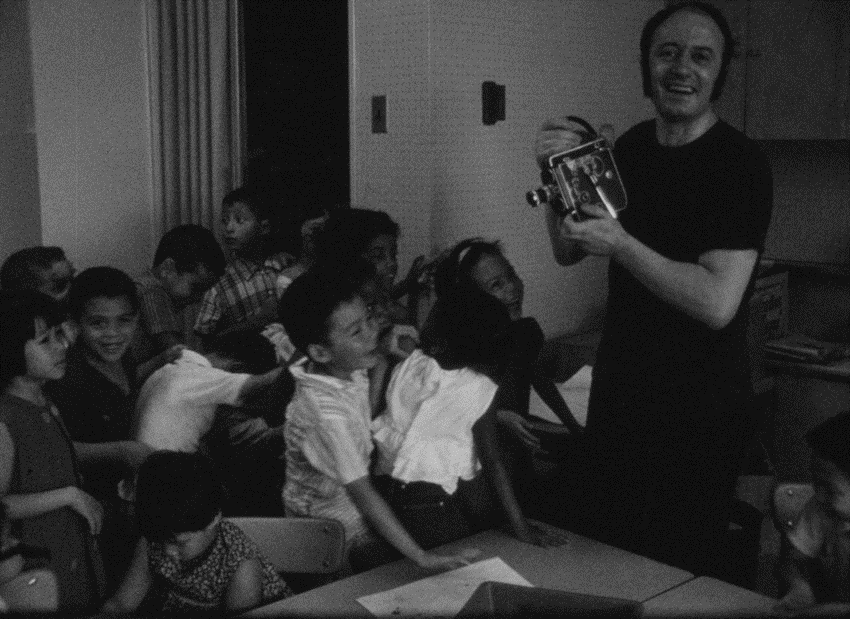
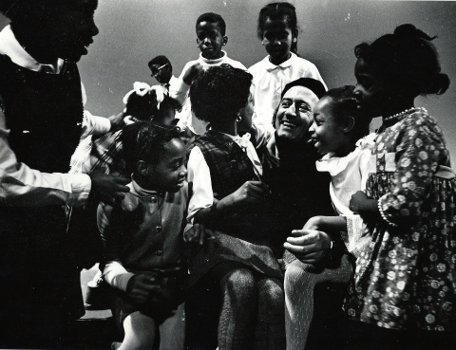
Tambellini with school children on the set of The Medium is the Medium, organized by WGBH Boston, ca. 1969
The Medium is the Medium, organized by WGBH Boston, part of the Experimental Television Workshop, aired in March 1969 with segments by Allan Kaprow, Paik, Piene, James Seawright, Thomas Tadlock, and Tambellini. This was the first program by artists, broadcast in a television station in the United States. The program showcased various opportunities to shift television from being solely a commercial marketing tool to a platform for creativity.
Tambellinii worked with Tracy Kinsel and Hank Reinbold from Bell Labs and began implementing Tambellini’s concept of a television tube that projects in a spiral pattern rather than a grid. Initially, Tambellini aimed to develop a television sculpture that would broadcast in a circular shape. Unable to achieve the circle, they eventually decided on a black spiral, which was a transformative distortion of received television signals and played a significant role in the early television art. Tambellini named this piece, Black Spiral and described it as a modified TV sculpture.
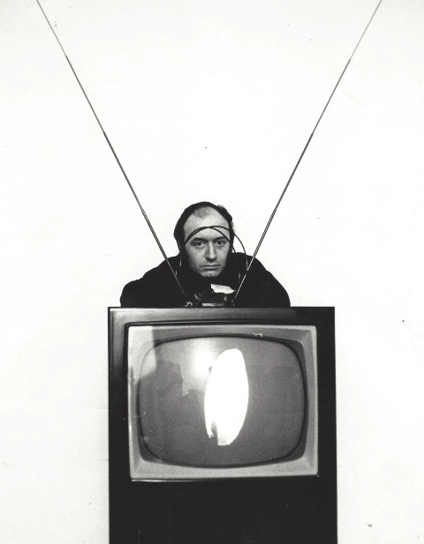
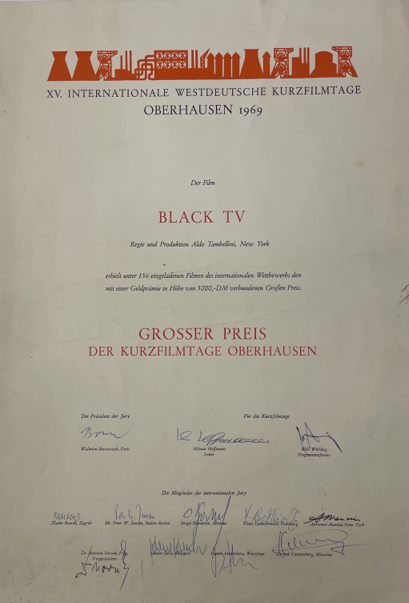
Tambellini’s Black TV, (1969) made with film and television footage was the winner of the Grand Prix, Oberhausen Film Festival in Germany.
The Gate Theatre closed and Tambellini moved from the Lower East Side to Brooklyn, NY. Due to limited space in Brooklyn, Tambellini decided to store his enormous body of work in Albany, NY.
1970
Tambellini exhibited in the first museum show on television as an art form in the United States, Vision and Television, at the Rose Art Museum, Brandeis University, Waltham, MA
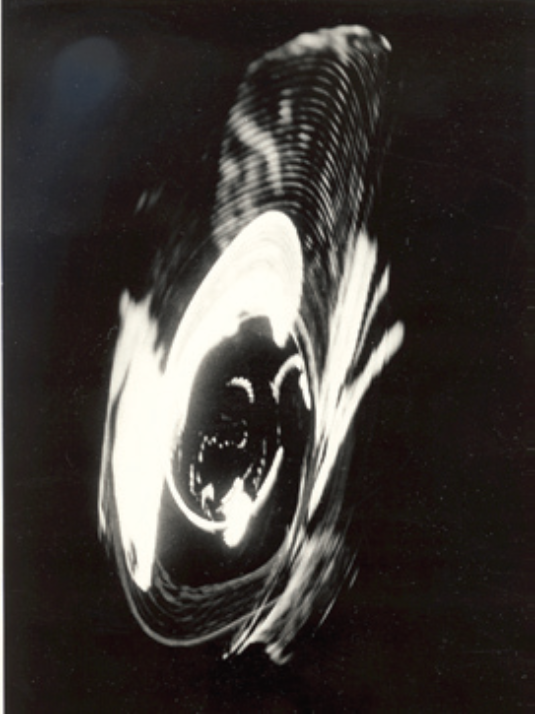
Black Spiral, (1969), a modified TV Sculpture, Vision and Television Exhibition, Rose Art Museum, Brandeis University, Waltham, MA, 1970
Primarily working in Harlem, NY, Tambellini becomes the Director of the Pilot Program in Video for New York State Department of Education.
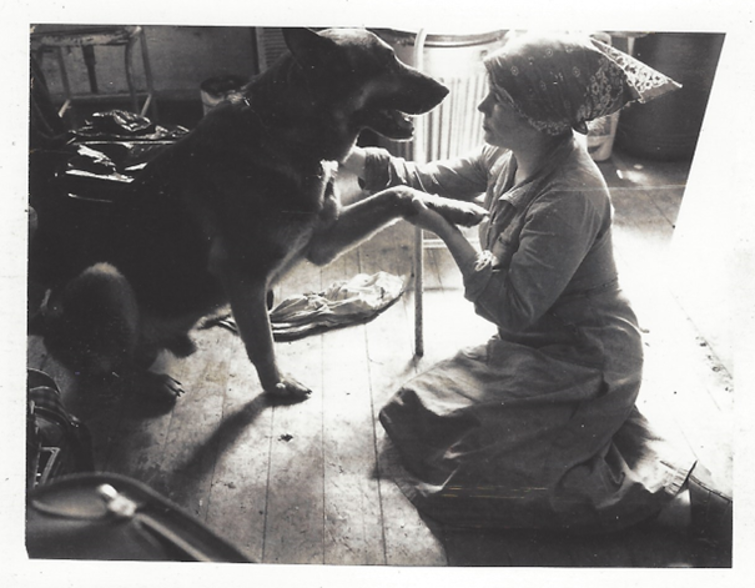
Sarah Dickinson with Tambellini’s beloved dog, Jet, ca. 1970
Tambellini met professional mime, Sarah Dickinson who became his partner and collaborated with him in almost all of his videos and performances for the next twenty five years.
In 1971, he documented the meetings and activities of the Italian-American Civil Rights League, including the Columbus Circle rally in which the league’s founder, Joseph A. Colombo Sr., was assassinated. Tambellini would go on to create over 40 tapes, documenting his two year involvement and the activities of the Italian-American Civil Rights League.
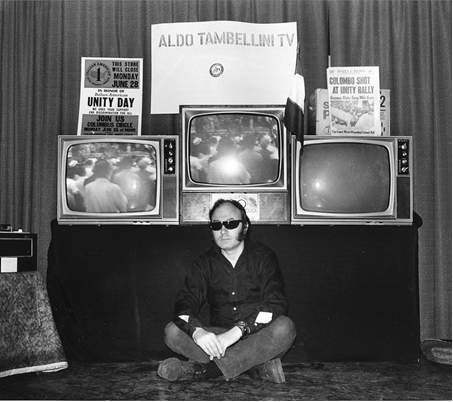
Tambellini with Installation, Colombo Shot at the Italian-American Rally, at the Avant-Garde Festival, NY
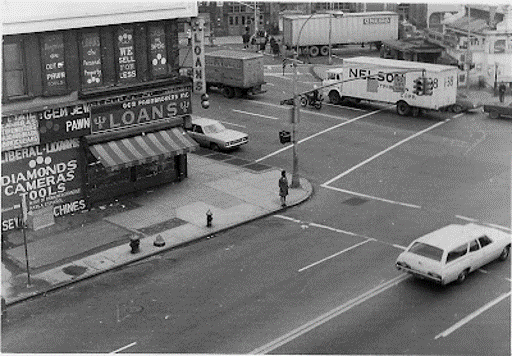
Frame from Tambellini’s Atlantic in Brooklyn
1972
Atlantic in Brooklyn, a one-man show is screened at The Kitchen Video Festival, NYC (a multi-channel video projection).
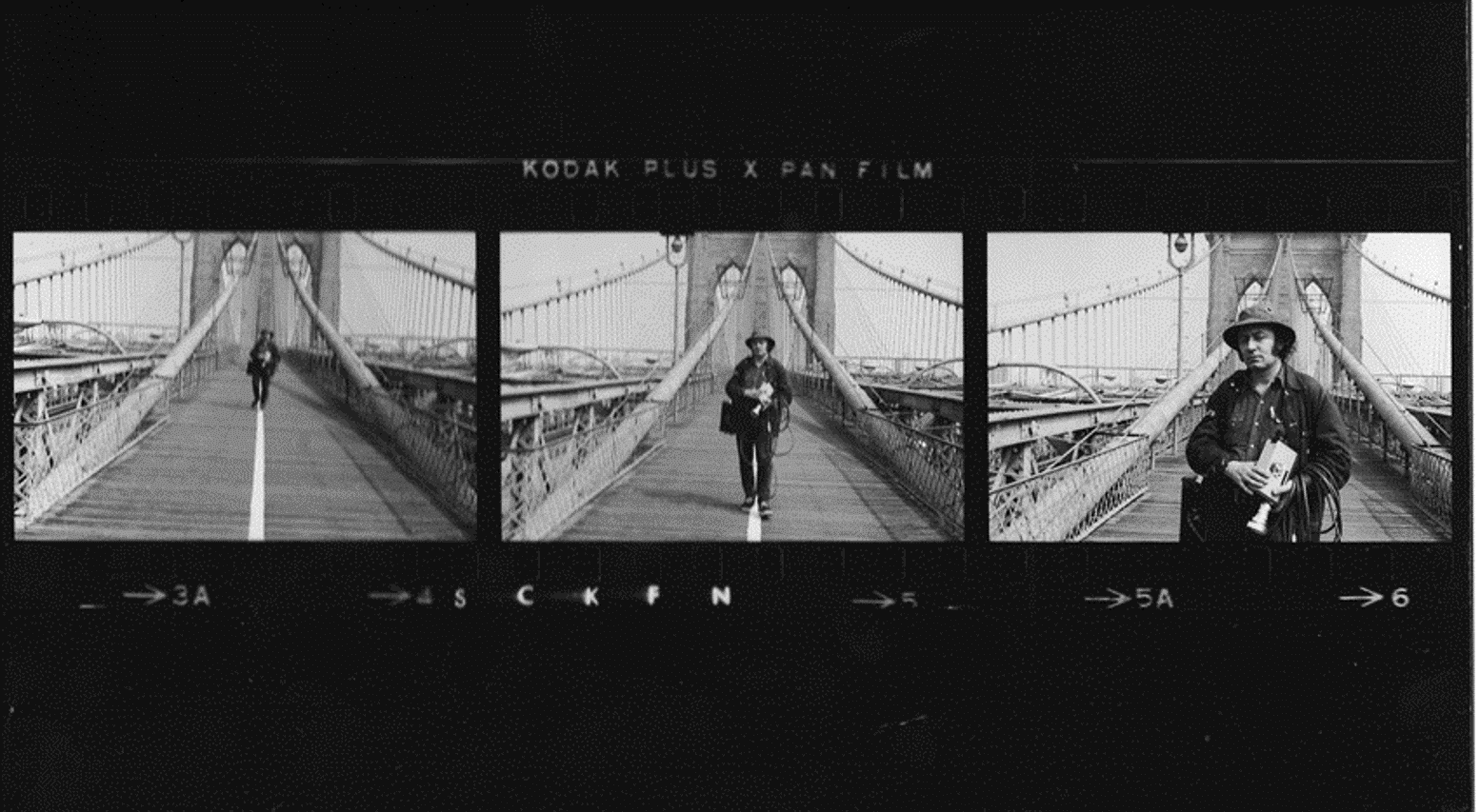
Tambellini crossing Brooklyn Bridge, NY, ca. 1970s
After the passing of artist, Ken Dewey, a group of friends attended Dewey’s memorial at his family farm in update New York. Tambellini videotaped the many artist, as they paid tribute to Ken, including Nam June Paik who played the piano, while Yoko Ono performed her Silent Scream and John Lennon looked on
1975
Otto Piene invited Tambellini to take part in Arttransistion, an event held at the Center for Advanced Visual Studies at the Massachusetts Institute of Technology. During this event, Tambellini collaborated with Sarah Dickinson to create 10 Second Delay, a piece Sarah Dickinson performed in.
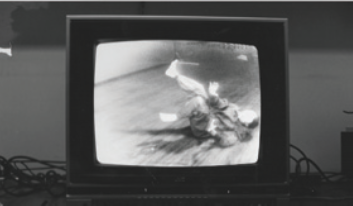
10 Second Delay, Sarah Dickinson performing, Everson Museum, Syracuse, 1976
NEXT CHRONOLOGY CHAPTER
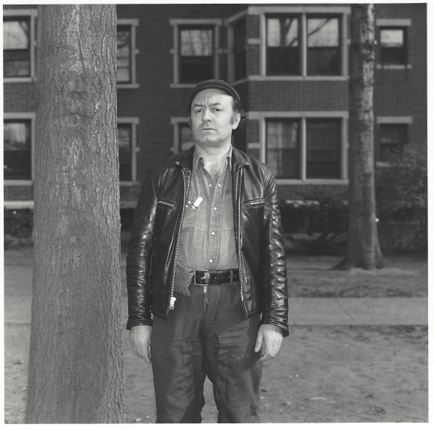
1976 – 1984
CAVS, MIT
During the period of 1976 to 1984, Tambellini held the position of Fellow at the Center for Advanced Visual Studies (CAVS) at the Massachusetts Institute of Technology (MIT). Throughout this time, he not only taught courses and conducted workshops but also actively engaged in various media and communication events worldwide. This period proved to be highly conducive for Tambellini's interactive concepts to come to fruition.
In 1980, he established “Communicationsphere,” a network aimed at fostering collaboration among artists, technicians, engineers, performers, and individuals concerned with the effects of tele-communications on contemporary society.


